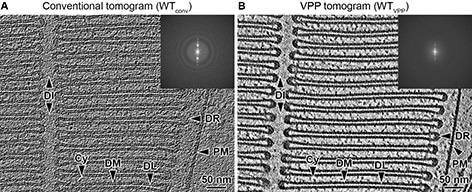Researchers from the University of California, Irvine, along with the Max-Planck Institute of Biochemistry, have discovered, at a molecular level, the structural determinants of the highly specialized rod outer segments (ROS) membrane architecture of the eye, which plays a crucial role in vision.

Using cryo-ET with a Volta phase plate (VPP), we can see individual proteins in native settings of rod cells without any staining. This represents the future of structural biology. Image Credit: School of Medicine, University of California–Irvine.
The study sheds light on the mechanics behind the pathologies of specific gene mutations. These mutations have been linked to blindness and have been discovered in genes encoding essential structural proteins in the ROS membrane. The study was published in the eLife journal.
Our findings indicate that these gene mutations could impede or completely prevent disk morphogenesis which, in turn, would disrupt the structural integrity of ROS, compromise the viability of the retina and ultimately lead to blindness.”
Krzysztof Palczewski PhD, Study Corresponding Author and Donald Bren Professor of Ophthalmology, School of Medicine, University of California, Irvine
Krzysztof Palczewski adds, “This study gives us insight into how the viability of the retina is compromised by diseases, like retinitis pigmentosa and Stargardt disease that affect structural proteins including peripherin of ABCA4. Armed with this data, we can now target new therapeutic approaches aimed at treating or potentially curing blindness.”
ROS’s highly ordered ultrastructure was first characterized more than five years ago, but its molecular organization remained a mystery until recently. The UCI-led team was able to obtain molecular resolution images of ROS using cryo-electron tomography (cryo-ET) and a new sample method of preparation.
Cryo-ET enabled us to image rim disc structures and to quantitatively assess the connectors between disks revealing the molecular landscape in ROS, including connectors between ROS disk membranes. With this information, we are able to address open questions regarding the close disk stacking and the high membrane curvature at disk rims, which are specialized and essential structural characteristics of ROS.”
Krzysztof Palczewski PhD, Study Corresponding Author and Donald Bren Professor of Ophthalmology, School of Medicine, University of California, Irvine
To put these new findings to the test, more research is needed, including human studies. However, initial signs suggest that emerging therapeutic techniques will most likely employ gene-editing technology, instead of pharmacological interventions or gene augmentation.
Source:
Journal reference:
Pöge, M., et al. (2021) Determinants shaping the nanoscale architecture of the mouse rod outer segment. eLife. doi.org/10.7554/eLife.72817.